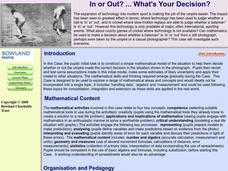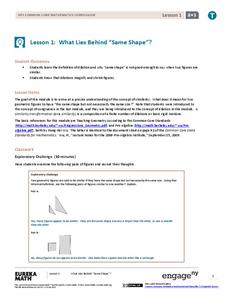EngageNY
End-of-Module Assessment Task: Grade 7 Mathematics Module 4
Asses the class to determine their knowledge of proportional relationships involving percents. Class members work through the nine-question assessment with a variety of percent problems. The multi-step problems involve simple interest,...
Bowland
In or Out? ... What's Your Decision?
Young mathematicians use photos and video clips to determine if a cricket player is "in" or "out." This analysis occurs using scale factors, distance-rate-time formula, and consideration of precision and accuracy.
Corbett Maths
Enlargements Using Ray Method
Figure out what to do when there is no grid to count. Using a ruler and a sharp pencil, the narrator shows how to perform a dilation when the figure is not on a grid. The ray method works by drawing a ray from the center of dilation...
Radford University
Kite Project
Let the class' knowledge of geometry soar like the kites they create. After researching the history and science of kites, learners draw up a blueprint for their own kites. They then calculate the areas and perimeters based on the scale...
Flipped Math
Similar Figures
Use some similar problems to find side lengths. Pupils learn the definition of similar figures and how it relates to corresponding angles and sides. Using the definition, individuals calculate the lengths of missing sides and practice...
WindWise Education
What Factors Influence Offshore Wind?
What is that out in the water on the horizon? Teams work together to study the coastline using maps to determine the best and worst locations to place an offshore wind farm. The teams then build a scale model wind farm to see what it...
Curated OER
Scale Factor- Surface Area and Volume
Young scholars calculate the surface area and volume of shapes. In this geometry lesson plan, students create different scales and calculate the volume and area for each shape. They compare and contrast between the different scales and...
Skills Workshop
Ratio, Scale, and Proportion
Converting units is an excellent example of how math relates to our everyday tasks. The resource prompts mathematicians to use baking, cooking, and other daily activities to discover how to make larger quantities of each ratio or recipe.
EngageNY
Making Scale Drawings Using the Parallel Method
How many ways can you create a dilation? Many! Individuals strengthen their understanding of dilations by using various methods to create them. The new technique builds on pupils' understanding of the ratio method. Using the ratio,...
101 Questions
Neptune
Examine an innovative approach to a large-scale model. Pupils across the state of Maine teamed up to create a model of the solar system that spans 40 miles. Put thinking skills to work within your classes as they make the calculations to...
Balanced Assessment
Ostrich and Seahorse
Examine the relationship between ratios and scale. Young math scholars compare ratios of two models. They use the ratios to make a comparison between the two models. Each image uses a different scale, which requires learners to think...
Under the Dome
Sphero Draw and Drive
Determine how far the ball rolled. The class watches a video of a person controlling a sphere rolling on the floor. Pupils develop some questions about the video and make estimates to the solutions of the questions. The teacher provides...
Illustrative Mathematics
Floor Plan
A multi-step problem has learners finding the actual area based on a scale drawing and then converting units at the end. Two different solution choices are listed depending on the preference on which step to start first. Both methods can...
Mathed Up!
Enlargements
Make enlargements with and without centers. Pupils work through seven problems dealing with dilations or enlargements. The first couple items are strict enlargements without centers, while the others have centers. Class members also...
Illustrative Mathematics
Box of Clay
What happens to a volume when you scale the dimensions of a rectangular prism? In this problem, a box of clay is increased in each dimension, with the intent to see if learners can generalize the result. The addition of physical models...
EngageNY
How Do Dilations Map Angles?
The key to understanding is making connections. Scholars explore angle dilations using properties of parallel lines. At completion, pupils prove that angles of a dilation preserve their original measure.
Curated OER
Measure: Bearings and Scale Drawings
Pupils practice drawing geometric figures. In this geometry lesson, learners complete an activity that requires them to draw angles and shapes to the nearest degree.
Curated OER
Similar Polygons
In this similar polygons worksheet, students identify the corresponding sides of polygons. They use proportions to solve problems. Students determine the scale factor of similar figures. This two-page worksheet contains diagrams and...
Curated OER
Using the Distance Formula
In this distance formula worksheet, students solve and complete 30 various types of problems. First, they find the exact distance between each pair of points and make a sketch of the situation. Then, students find the center, horizontal...
Curated OER
House Project
Make young mathematicians' dreams a reality with this fun drawing project. Given the task of designing their dream home, students create drawings and physical models that demonstrate their understanding of proportion and scale.
Noyce Foundation
Which is Bigger?
To take the longest path, go around—or was that go over? Class members measure scale drawings of a cylindrical vase to find the height and diameter. They calculate the actual height and circumference and determine which is larger.
EngageNY
What Lies Behind “Same Shape”?
Develop a more precise definition of similar. The lesson begins with an informal definition of similar figures and develops the need to be more precise. The class learns about dilations and uses that knowledge to arrive at a mathematical...
Virginia Department of Education
Attributes of a Rectangular Prism
A change is coming. Pupils use unit cubes to investigate how changes in the length, width, and/or height affects volume and surface area. They extend the results to write and test predictions on the effect of changing multiple sides on...
Benjamin Banneker Association
Celebrate Benjamin Banneker
Inventor, astronomer, surveyor, mathematician, clock maker. Learners celebrate the life of Benjamin Banneker by building creative analog clocks, making scale models, and solving problems related to surveying. The activities model the...
Other popular searches
- Triangles Scale Factor
- Scale Factor Enlargement
- Proportion Scale Factor
- Scale Factor Problems
- Figuring Scale Factor
- Dilations and Scale Factors
- Coordinate Grid Scale Factor
- Geometry Scale Factor
- Scale Factor Problems Shapes
- Scale Factor Proportions
- Scale Factor Worksheets
- Measurement Ans Scale Factor

























